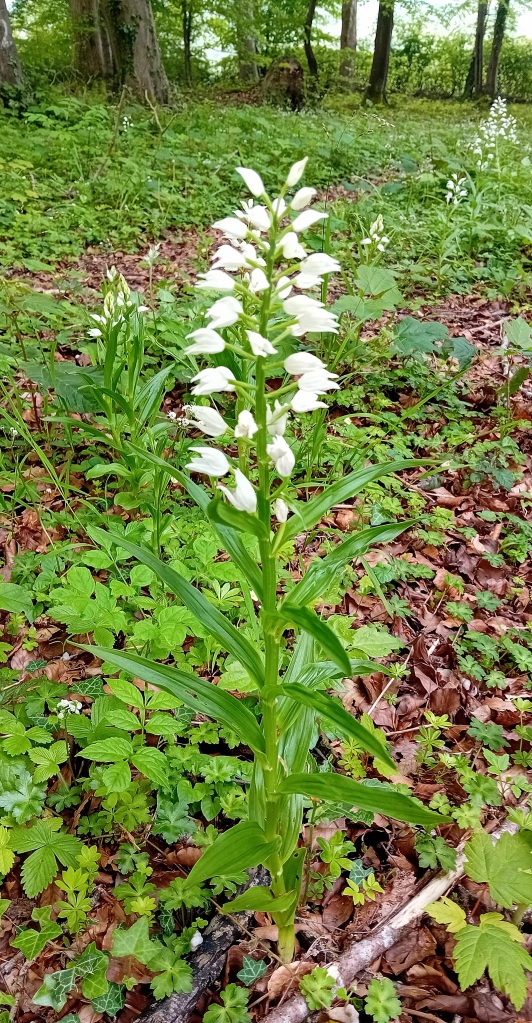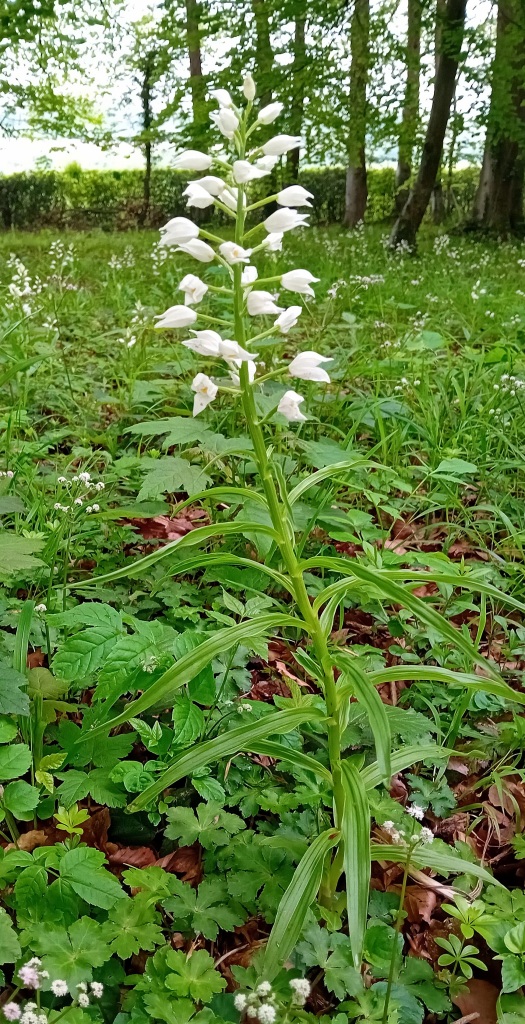Before observing this Orchid for the first time earlier this week, I had intended to visit what is renowned as a British stronghold for them. Getting close to those Gloster plants would have involved scrabbling around a very steep slope in damp, slippery conditions, my days for doing which are now probably in decline. So wishing to make the most of the current fair weather window I stuck to plan A today.
Chappett’s Copse (GU32 1NB – SU653234 – see here), a Hants and IoW Wildlife Trust reserve near West Meon, is a remnant of ancient woodland that hosts a notable array of wild plants and fungi. From the entrance and parking area a well-defined track runs northward, along which I soon noticed Sword-leaved Helleborine on either side. Then the woodland opened into a glade that was carpeted with hundreds of them, an impressive sight indeed (pictured below). The red-listed plant is in decline and nationally scarce, now occurring in less than 20 locations, so for such a profusion to be in one place here seemed quite remarkable. This is just one of two sites with more than 1000 plants, having possibly up to 4000.
The white flowers are not dissimilar to the more widespread White Helleborine (see here), though purer toned and more bell-shaped. Typically growing to around 40cm in height, Sword- or Narrow-leaved is a more stately plant, and the really noticeable difference is in the shape of the long, narrow leaves that radiate in all directions. My Gloster records (see here) had conveyed that structure of the plant, though at a certain distance and through clutter, so now I needed to do do justice to both flowers and leaves. That cause was not helped when upon arrival I found I had left my SHDC card at home, but in the event my phone proved adequate as well as capturing some habitat context in the following images.



I expected the viewing area to be enclosed but it is possible to walk around freely. There was ample opportunity to gain acceptable studies from well-trodden paths, without needing to go into the habitat. SWH grows in open, damp Beech (such as here) or Oak-Ash woodland on calcareous soils. It requires certain lighting conditions and being a slow growing plant from tough and congested root stock rather than tubers is sensitive to compaction of the soil. So woodland management at Chappett’s Copse to which SLH responds slowly – especially under-storey thinning, coppicing, and maintaining ridges and glades – is geared to catering carefully for those needs.
The main causes of decline elsewhere are:
- Rapid clear-felling of sites leading to lush re-growth of the understory and consequent shading of individual plants
- Lack of maintenance of rides and glades
- Unsuitable tree planting particularly of conifers
- High levels of deer browsing
- Roadside populations being lost to road realignment
At Chappett’s Copse and other Hants sites, the introduction of a wood meadow mowing system, combined with careful tree removal has dramatically increased the number of flowering plants by up to 80 stems per season. Populations can then become self-sustaining requiring considerably less management in habitats that remain open. Conversely, removal of all trees could lead to increases in competitive ground flora, restricting growth. Moderate sun levels lead to greater insect visitation, and therefore higher seed set. Conversely, high sun levels may lead to burn-out and reduced flowering.
That regime which provides the required open, dappled shade was readily apparent to my untrained eye in the glade, and the whole reserve had a superbly well-managed air. Further information on all this may be found here. This visit today offered a fascinating insight into habitat creation and maintenance to benefit one of Great Britain’s most vulnerable Orchids.

